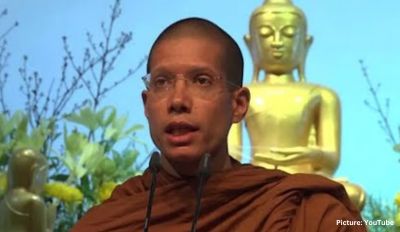
Steve Jobs swore by this easy trick to boost his creativity and solve just about any problem
It's backed by science..

Steve Jobs in 2010
Do you ever get stuck on a problem while sitting at your desk and can’t find a solution? You wrack your brain, but you only seem to get more frustrated instead of closer to solving the issue. Steve Jobs had a way of finding inspiration when he felt his thoughts were stuck in the mud. He got up and took a walk.
Jobs was the visionary co-founder of Apple whose creativity, innovation and passion changed how people live and connect.
How did Steve Jobs solve problems?
According to Inc. , Jobs' biographer Walter Isaacson said, “Taking a long walk was his preferred way to have a serious conversation.” “So much of our time together was spent quietly walking,” recalled legendary designer Jony Ives. Jobs did a lot of his creative thinking while walking. He often strolled around Apple’s Cupertino, California neighborhood, often holding meetings with people as they walked.
You don’t have to go this far, but Jobs often liked taking these walks barefoot.
Why is talking a walk good for creativity?
Science supports the idea that walking can boost one's problem-solving abilities. A report from Stanford found that walking can raise one's creative output by as much as 60%. “Many people anecdotally claim they do their best thinking when walking. We finally may be taking a step, or two, toward discovering why,” Oppezzo and Schwartz wrote in the study published in the Journal of Experimental Psychology: Learning, Memory and Cognition.
The researchers gave 3 reasons why they think walking is so great for creativity:
1. Mindfulness: Walking in a natural setting can reduce mental clutter and enhance focus, allowing one to see the problem with fewer mental distractions.
2. Associative thinking: The rhythmic movement of walking could stimulate the brain’s associative networks, making connecting ideas easier.
3. Freedom and exploration: Getting up and moving about may inspire a greater sense of freedom and exploration, opening you up to fresh ideas.
Another reason taking a walk is helpful to come up with fresh ideas is that breakthrough ideas often happen when the brain switches from the executive network to its default network. The executive part of the brain is goal-focused and task-oriented, but the default network is where we brainstorm. According to “In The Net and the Butterfly: The Art and Practice of Breakthrough Thinking,” authors Olivia Fox Cabana and Judah Pollack believe that when you’re on a walk, you have the best chance of both modes cooperating. "If we had to choose one single mindless activity for you to do, it would be walking," Cabana and Pollack conclude.
How do you get creative on a walk?
Writing tutor Sarah Salway says that if you want to walk to solve a problem, it’s best to have a clear idea of what you’re trying to solve.
“You might want to formulate a question before you start walking. As you walk with your question in mind, where your attention falls may guide you to an answer. It can be a good exercise to do with a friend. When I’ve done this, it’s astonishing how we notice completely different things and how each of us answers our own questions,” Salway writes in Psychology Today.
Next time you get stuck on something, staring at your computer screen or a blank paper sheet won’t do you much good. Get out and take a walk, preferably with a friend or colleague, to bounce ideas off of. And, if you want to walk in Jobs’ shoes, take off yours and feel the ground beneath your feet as your mind reaches for the sky.
- How do you know someone is very smart? Here are 15 'subtle signs' people notice. ›
- Bill Gates explains the ‘safest’ age to give a kid a cellphone ›
- A son posted his nervous mother’s painting online and it set off a chain reaction of creativity ›
Sweden makes stunning decision to trademark its name to avoid confusion
The country is taking historic steps to fix the problem..
A Swedish woman taking things into her own hands.
Sweden has existed for over 1,000 years, but travelers across the globe are confused because other places, inspired by the country’s untouched beauty and joyously inclusive culture, have taken its name.
Seven other places in the world call themselves Sweden, so to distinguish itself from the name-alikes, the Kingdom of Sweden is taking a bold, historic step that no country has before. It’s become the first to apply to trademark its name with the European Union Intellectual Property Office.
Visit Sweden likens the country’s problem to a luxury brand that has to contend with dupes, knockoffs, or bootlegs that fall short of the glory of the genuine article.
“It’s flattering that other places want to be called Sweden, but let’s be honest, there should only be one. Our Sweden. The one with the Northern Lights, endless forests, and the world’s best flat-pack furniture,” says Susanne Andersson, CEO at Visit Sweden.
By trademarking its name, Sweden will make things much less confusing for travelers worldwide. It’d be a shame for someone looking to visit Sweden’s majestic Lapland to mistakenly wind up in a place with no reindeer, Aurora Borealis, or cloudberries to be found.
The world-class research team at Visit Sweden knew it had to act when it realized that other destinations with the same name had tripped up travelers. People looking to vacation in Portland, Oregon, have accidentally wound up in Portland, Maine. Travelers yearning to experience the fall in Manchester, New Hampshire, have been deplaning in Manchester, England. “It happens more than you think!” the researchers admitted.
The E.U. Intellectual Property Office must act swiftly and allow Sweden to trademark its name so that travelers worldwide don’t miss the opportunity to experience an utterly unique country known for its serene landscapes, commitment to deep relaxation and personal freedom.
No one should ever miss out on staying on one of Sweden’s 267,570 islands, more than any other country. The Swedish archipelagos offer luxurious glamping, peaceful hikes, tranquil solitude and awe-inspiring, pristine nature.
Sweden is a beautiful place to visit all year round, with bright summers, colorful falls, vibrant springs and dark, crisp winters. It is also a place to delight your tastebuds with a cuisine centered on healthy, locally sourced produce, with some preparation methods dating back to the Viking era.
The original Sweden is a place where one can relish Old World European history while also enjoying the modern pleasures of the most progressive countries in the world. Travelers can be whisked back into history by visiting the Naval Port of Karlskona, a well-preserved European naval town from 1680. Or, enjoy cutting-edge design, delicacies, art, music and culture in hip metropolitan destinations such as Stockholm or Sweden’s “coolest city,” Gothenburg.
Did we mention Sweden has an ABBA museum? Wait till the other 7 Swedens find out about that.
As you can see, Sweden is an incredibly unique destination that cannot be duplicated. It would be a tragedy for anyone intending to visit the original Sweden to mistakenly find themselves in a name-alike place that lacks its Scandinavian charm. You can do your part to stop the confusion by signing a petition to let Sweden trademark Sweden at Visit Sweden (the original) .
- Sweden’s landmark new proposal will stop the world from mixing it up with Switzerland ›
- Non-Americans are sharing the ‘dead giveaway’ someone is American and they are pretty right ›
- The Swedish resistance to feeding guests may not actually be as rude as it seems ›
Woman who was pressured to quit her job to raise stepdaughter's baby makes a bold decision
This sparked an important conversation about family responsibility..
When parents can't step up, should grandparents step in?
A story that recently went viral on Reddit’s AITA forum asks an important question: What is a parent’s role in taking care of their grandchildren ? The story is even further complicated because the woman at the center of the controversy is a stepparent.
At the time of writing her post, the woman, 38, met her husband Sam, 47, ten years ago, when his daughter, Leah, 25, was 15. The couple married five years ago after Leah had moved out to go to college.
Leah’s mom passed away when she was 10.
When Leah became pregnant she wanted to keep the baby, but her boyfriend didn’t. After the disagreement, the boyfriend broke up with her. This forced Leah to move back home because she couldn’t afford to be a single parent and live alone on a teacher’s salary .
Leah’s story is familiar to many young mothers facing similar difficulties.
The father isn’t involved in the baby’s life as a caretaker or financially. Sadly, research shows that 33% of all children in the U.S. are born without their biological fathers living in the home.
Single motherhood comes with unique hardships.
via Alexander Grey/Unsplash
The new mother is a teacher and can’t afford to live on her own with a child. In 2019, a study found that out the top 50 U.S. cities, Pittsburgh is the only one where a new teacher could afford rent.
Today, Portland, OR has joined the very short list of cities where an "average teacher can afford 91.3% of apartments within community distance of their school" according to a recent study .
The stressors of taking care of the baby made Leah realize she needed help.
“But once she had the baby around 4 months back, Leah seemed to realize having a baby is not the sunshine and rainbows she thought it was,” the woman wrote on Reddit. “She barely got any sleep during the last four months. All the while Sam was helping her with the baby while I did almost all chores myself.”
“Now her leave is ending. She did not want to leave the baby at daycare or with a nanny,” the woman continued. “Sam and I both work as well.”
Leah asked her stepmother if she would stay home with the baby. The stepmother said no because she never wanted to have a baby and she has a job. “I asked why Leah can't stay home with the baby herself,” the woman wrote. “She said how she was young and had to build a career. I said many people take breaks to raise kids, and she broke down crying about how she was so tired all the time being a mom and needed something else in her life too.”
The demands of new motherhood are usually all-encompassing.
via Pixabay
After the woman told her stepdaughter no, her husband pressured her to stay home with the baby. But she refused to give up her job to raise her stepdaughter’s child. “Leah said yesterday how she wished her mom was alive since she would have had her back. She said I didn't love her, and my husband is also mad at me,” the woman wrote. The woman asked the Reddit community if she was in the wrong for “refusing to help my stepdaughter with the baby,” and the community responded with rapturous support.
"[The woman] should tell her husband to knock it off and stop trying to pressure her into raising his daughter’s baby. If he wants a family member to look after her baby while she works, then he can do it," user Heavy_Sand5228 wrote.
"This is Leah's baby that she alone chose to have. That doesn't obligate you to change YOUR life to suit her desires. The whole business of saying you don't love her because you won't quit your job to watch her baby is manipulative and messed up, and I'm shocked your husband is siding with her," user SupremeCourtJust-a** added.
Leah and many women like her are in this situation because, in many places, teachers are underpaid, rent is high, and not all dads pay child support, even those required by law.
Another commenter noted that the baby is much more the father’s responsibility than the stepmother's. "To add, Leah should consider seeking child support from her ex. Her kid should be getting that money," Obiterdicta wrote.
While there are resources to help stepparents connect with their stepchildren and step-grandchildren, it's important to remember that the responsibility to raise a child ultimately rests with the parent(s).
This article originally appeared last year.
- Man's reaction to hearing his stepdaughter call him 'Dad' is an emotional masterpiece ›
- Here's to the stepdads who step in and step up to fatherhood. ›
- 5 things stepkids want stepparents everywhere to know. ›
5 things that made us smile this week
The animal edition.
Been stressed this week? Who hasn’t. That’s why we’re bringing you the latest in good news—five animal-themed stories we guarantee will put a smile on your face.
This week, we’re celebrating:
The most entertaining animal photos you've ever seen
Jason Moore/Comedy Wildlife Photography Awards 2023 and © Tzahi Finkelstein /Comedy Wildlife Photography Awards 2023
Need a laugh? How about a dozen laughs? Look no further than the 2023 Comedy Wildlife Photography Awards , a competition started in 2015 that focuses on the lighter side of wildlife photography. More than 1,800 photographers from around the world submitted photos, and the finalists—from a kangaroo playing air guitar to an arguing set of greenfinches—will absolutely make your day.
Healthier, happier, rescued pets
Hundreds of thousands of pets are relinquished to shelters each year, and many vulnerable pet populations—such as disabled and elderly dogs—can be hard to place in loving homes. Fortunately, Subaru has sponsored the rescue, rehabilitation, and adoption of more than 134,000 of these pets through the Subaru Share the Love® Event . As the largest corporate donor to the ASPCA® (The American Society for the Prevention of Cruelty to Animals®), Subaru and its retailers are donating a minimum of $300 to charities like the ASPCA for every new Subaru purchase or lease during the 2024 Subaru Share the Love Event, happening now through January 2, 2025.
This animal-centric (and adorable) creative writing assignment
View this post on Instagram A post shared by Amy • 3rd Grade Teacher (@theuniqueclassroom)
Amy McKinney, a third-grade teacher in Pennsylvania, recently had a genius idea for teaching her class persuasive writing: Rather than have them formulate an argument for an imagined audience (boring!), McKinney partnered with a local animal shelter and had her class write persuasive descriptions of each animal to help them get adopted. Each student chose a pet to write about and sent their essays to the shelter to display and post to the shelter’s social media channels. Student engagement was “tremendous,” said McKinney, and there’s no doubt these persuasive paragraphs made a huge difference in these shelter pet’s lives. Adorable.
The dog who saved his owner with CPR (yes, really)
Dogs have made the news for saving humans before, but have you ever heard of a dog performing CPR ? That’s exactly what Bear, a Siberian Husky-Golden Retriever mix, did in 2022 when he found his owner unconscious on the floor after suffering a major heart attack. Not only was Bear able to quickly call for help, he even jumped on his owner’s chest repeatedly while someone else called the paramedics. Thanks to Bear, the owner survived what should have been a fatal heart attack. Now that deserves some head scritches.
Bee populations have reached a record high
Honeybees are essential to the planet, as they pollinate over 130 types of fruits, vegetables, and nuts. For years, honeybee numbers have been in decline—but happily, that’s starting to change. The US has added almost a million bee colonies in the past five years, with more than 3.8 million honeybees in total.
For more ways to smile, check out how Subaru is sharing the love this holiday season.
- Dog instinctively gives owner CPR saving him from a massive heart attack ›
- Third graders wrote these adorably persuasive descriptions for local shelter animals ›
- 14 of the funniest photos from the 2023 Comedy Wildlife Photography Awards ›
- 5 things that made us smile this week ›
15 hilarious parenting comics that are almost too real
They're funny because they're true..
Fowl Language by Brian Gordon
Brian Gordon is a cartoonist. He's also a dad, which means he's got plenty of inspiration for the parenting comics he creates for his website, Fowl Language (not all of which actually feature profanity). He covers many topics, but it's his hilarious parenting comics that are resonating with parents everywhere.
"My comics are largely autobiographical," Gordon tells me. "I've got two kids who are 4 and 7, and often, what I'm writing happened as recently as that very same day."
Gordon shared 15 of his oh-so-real comics with us. They're all funny 'cause they're true.
Let's get started with his favorite, " Welcome to Parenting ," which Gordon says sums up his comics pretty well. "Parenting can be such tedious drudgery," he says, "but if it wasn't also so incredibly rewarding there wouldn't be nearly so many people on the planet."
I hope you enjoy these as much as I did.
“Welcome to parenting."
via Fowl Language
All comics are shared here with Gordon's express permission. These comics are all posted on his website, in addition to his Facebook page. You can also find a "bonus" comic that goes with each one by clicking the "bonus" link. Original . Bonus .
Eating is never fundamental.
Original . Bonus .
Adjusting the coping mechanism.
I used to be cool.
Naps happen.
Original. Bonus .
Rolling with the punches.
Tears happen.
It’s time to get up.
The benefits of experience.
Everyone gets therapy, yea.
Everyone has a role to play.
What’s up doc?
Everyone gets a participation ribbon.
Perception shifts.
I love Gordon's comics so much because they're just about the reality of parenting — and they capture it perfectly.
There's no parenting advice, no judgment, just some humor about the common day-to-day realities that we all share.
When I ask him about the worst parenting advice he's ever received, Gordon relays this anecdote:
"I remember being an absolute sleep-deprived wreck, sitting outside a sandwich shop, wolfing down my lunch quickly beside my 1-month-old son, who was briefly resting his lungs between screaming fits. A rather nosy woman walked up to me and said, all smugly, 'You should enjoy this time while they're easy.' It was the exact worst thing anyone could have said to me in that moment and I just wanted to curl up on the sidewalk and cry."
Who hasn't been on the receiving end of totally unneeded and unwanted advice? That's why Gordon's comics are so welcome: They offer up a space for us to all laugh about the common experiences we parents share.
Here's to Gordon for helping us chuckle (through the tears).
This article originally appeared eight years ago.
- Mom's comics illustrate the parenting double standard - Upworthy ›
- Nine things new parents think they need and practical alternatives - Upworthy ›
- Child development Phd shares parenting advice - Upworthy ›
- 10 things that made us smile this week - Upworthy ›
- Woman finds out daughter is labeled a 'flight risk' at school - Upworthy ›
- Little girl shocks her mom by pulling out a pocket full of worms - Upworthy ›
- Dad tells child their mom has rabies in funny misunderstanding - Upworthy ›
- Mom shares wild story of how her daughter kidnapped a baby - Upworthy ›
- Mom shares PSA on about being a sports mom while also working - Upworthy ›
- Woman calls cops on another parent and regrets it - Upworthy ›
- Her boyfriend asked her to draw a comic about their relationship. Hilarity ensued. - Upworthy ›
- Mom teaches daughter a perfect lesson after she threw her new pencil case in the trash. - Upworthy ›
Parents get a wave of support after their family has 'unhinged' reaction to new baby's name
Hope their family was taking notes..
Unsolicited opinions aren't just annoying. They can be hurtful.
Sure, parents sometimes make an… interesting choice when it comes to naming their child . But the key word there is "choice." It probably goes without saying that it’s not the best move to insert an opinion on something rather personal and vulnerable like a child's name, especially when that opinion is not requested.
But nonetheless, people do cross this boundary, expressing their disapproval and giving new moms and dads yet another reason to second-guess themselves.
At first, everything went smoothly.
“I just had a baby this week,” the mom wrote in her post. “We were still in the hospital when we announced her name and got a slew of the usual responses that normal, sane people say when hearing about the name of a baby (‘what a lovely name!’). Because saying anything different is insane, right?”
But when her husband texted his side of the family to share their newborn daughter’s name, all hell broke loose.
Mind you, these parents didn’t name their child Watermelon Gumdrop or Fern Gully or something else truly out there. The name they chose, which caused them a lot of unnecessary grief, was Rosa.
Not only does Rosa (the Spanish word for “rose”) sound lovely, it carries all poetic meaning symbolized by the flower: hope, love, and courage. What’s not to like?
Rosa is a baby girl name of Mexican origin.
But instead of celebrating their name choice, the mother-in-law apparently responded with, ““No, I don’t really like that name. I much prefer Violet.”
“We were stunned,” the woman continued. “I simply cannot imagine being a family member who’s being INFORMED of a newborn’s name, and thinking you should have input…We LOVE our daughter’s name, and did not want to have our first moments with our daughter marred by this comment.”
But wait, it gets worse.
The husband's family then called several times after their texts were ignored. The following day, the husband’s sister also sent a barrage of texts with “alternatives [that] she prefers.”
Then, when told that the entire family on the mom’s side supported the name, the mother-in-law laughed and said, “They must not have good taste—nobody here likes it. Nobody.”
Now, this next part really shows the effect this appalling behavior had on the new parents:
“We are sleep deprived. Coming down from an emotional high, during which our daughter was in NICU and I almost needed a blood transfusion because of how much blood I lost. My husband, so stoic and assured, is f**king crushed. I’m FUMING. I will NEVER forget how they made my husband feel during one of the most vulnerable and special times in his life,” the mom wrote.
Most Unhinged Reaction To Naming Your Child? by u/UWhatMate in namenerds
People who read this woman’s story were “livid” on her behalf, and rallied to give her some long overdue support.
“What on earth is wrong with Rosa???? It’s a beautiful name!! Tell your mother-in-law she is ridiculous and she can shut up immediately, if not sooner,” one person commented.
Another pointed to how truly ridiculous this situation was, writing, “The name is ROSA? I thought from reading this that it was at least going to be a controversial name. Rosa is beautiful. Even if it’s not your cup of tea, it’s hard to find anything wrong with it. OP should take this as the sign it is and reevaluate their individual relationships with that side of the family.”
Several even suggested going into little-to-no-contact mode with that side of the family, since odds are they wouldn’t prove any more helpful in the stressful postpartum days to come.
“Tell her she doesn’t need to meet baby if she is so insistent on the name being changed,” one person commented.
Sadly, sometimes stronger boundaries must be established with those who will not respect more lenient ones, especially when it comes to family members—and especially when it comes to parents trying to raise their kids in the most healthy environment possible. Hopefully these parents were able to move forward and enjoy welcoming little Rosa into the world.
- Mom's video on why parents should give their kids adult names, not baby names, has parents debating ›
- Woman nearly loses friend after admitting her baby names are 'godawful' and dangerous ›
- Husband asks the world for help after fallout from wife's secret choice of 'horrible' baby name ›
- Family calls mother-to-be's baby name 'abusive' - Upworthy ›
- Dad intervenes after daughter chooses 'nightmare' baby name - Upworthy ›
- Woman's husband wants to give their daughter the 'worst' name - Upworthy ›
- Mom wonders if she shouldn't have given her son adult name - Upworthy ›
- Baby name expert says these 80s girl names did not age well - Upworthy ›

Mom shares the hard truth about men who want kids versus those who want to be fathers
There's a huge difference between the two..
A lazy dad versus an attentive father.
Many men say they want kids, but does that mean they also want to take on the full responsibilities of being a father ? That’s the big question at the crux of a recent viral TikTok post that everyone who wants kids with a man should consider. The question has traditionally been, “Does he want kids?” but Abby Eckel thinks we must dig deeper.
Abby Eckel is a social media influencer and blogger who discusses women’s rights, focusing on equal division of labor in the home. In her video, she breaks down the differences between the 2 types of men. “Men are taught to want kids, but not how to be dads. There are lots of men that want to have kids. There are fewer men that want to be dads, and it's really important, as women, that we discern between the two, because they're not the same,” Eckel says.
What’s the difference between being a dad and being a father?
“A man that wants kids , he's thinking legacy. He's thinking caring on the family name, having little mini-me's running around, having kids running around, the milestones, the highlight reel,” Eckel continues. “Very few men though, when they think about, ‘I want to be a father’, are they thinking about the daily grind task, the midnight feedings, the diaper changes , the to and from of the inevitable sports that they'll play.”
@abbyeckel I cannot emphasize these differences enough.
Eckels question is fundamental because if someone mistakes a man saying “I want kids” with “I want to be a father,” they may unwittingly sign themselves up as the default parent in a relationship. They will have to assume the mental load of parenting because dad fails to take any initiative. In this arrangement, the dad simply becomes someone who plays with the kids on occasion and has to be told what to do. This places the default parent in a position where it’s nearly impossible not to develop some r esentment for their spouse.
On the other hand, a man who wants to be a father will be proactive and an equal partner in parenting duties.
Eckel believes that a big reason why some men fail to step up and become fathers is because they weren’t taught to be nurturing as children. “We bombard boys with messages about being providers, protectors. But when's the last time you actually saw a boy being taught how to nurture? How many young male babysitters do you have on your roster? I don't have any. How many little boys do you see walking around with a baby doll, feeding her, changing her diaper?” she asked.
The post resonated with many of Eckel’s followers, who think there are a lot of men out there who aren’t stepping up and taking responsibility. “Same for being married. Do they just want a wife, or do they want to BE a husband,” Dana wrote. “Being a Father and being a Dad are 2 different things. Your father is the person who helped create you, your dad is the man who helped raise you. They're not always the same person,” Izzie added.
“If you really want to see how a family acts, go to any theme park and watch a family of three or more. You can see just how much the mother goes through in a day with the kids while the father eats snacks,” Athena commented.
Ultimately, Eckel says the difference between a dad and a father is someone who takes initiative. “So, before you have kids with a man, watch how they handle responsibility. Do they take initiative on things, or are they always sitting back waiting for you to tell them what to do? Do they notice what needs to be done without being asked?” she explained.
- Mom told not to breastfeed at water park perfectly explains why the decision was ridiculous ›
- Hate cleaning? Here are 10 crowdsourced 'lazy hacks' for keeping any home spotless ›
- As a woman, I was written off as lazy and disorganized. My unexpected diagnosis? Autism. ›
Stanford expert shares the number one phrase that people good at small talk always use
Golden retriever's unbridled excitement over new dog bed is too sweet not to watch, nicole kidman shares the unconventional marriage rule she has with husband keith urban, 'wicked' author reveals how one line in 'the wizard of oz' inspired elphaba and glinda's story, hospice nurse shares clue she uses to know if someone is dying 6 months before it happens, woman with unfortunate initials warns parents to be more careful naming their kids.
- SUGGESTED TOPICS
- The Magazine
- Newsletters
- Managing Yourself
- Managing Teams
- Work-life Balance
- The Big Idea
- Data & Visuals
- Case Selections
- HBR Learning
- Topic Feeds
- Account Settings
- Email Preferences
Steve Jobs Solved the Innovator’s Dilemma
- James Allworth
In the lead up to today’s release of the Steve Jobs biography, there’s been an increasing stream of news surrounding its subject. As a business researcher, I was particularly interested in this recent article that referenced from his biography a list of Jobs’s favorite books. There’s one business book on this list, and it “deeply […]
In the lead up to today’s release of the Steve Jobs biography , there’s been an increasing stream of news surrounding its subject. As a business researcher, I was particularly interested in this recent article that referenced from his biography a list of Jobs’s favorite books . There’s one business book on this list, and it “deeply influenced” Jobs. That book is The Innovator’s Dilemma by HBS Professor Clay Christensen.
- JA James Allworth is the Director of Strategy for Medallia , Inc, co-host of the Exponent podcast , and co-author of How Will You Measure Your Life? . Connect with him on Twitter at @jamesallworth . To receive an email when he posts, click here .
Partner Center

Steve Jobs’ Secret to Problem Solving: The 10-Minute Rule and How It Can Help Your Brain

When faced with a complex issue at work, you might sit at your desk, stressing over the solution. After ten minutes of intense focus, you still come up blank. What should you do? If you were Steve Jobs, the answer was simple: get up and take a walk.
“Taking a long walk was his preferred way to have a serious conversation,” writes Jobs’ biographer, Walter Isaacson. Legendary designer Jony Ives also recalls, “So much of our time together was spent quietly walking.” It’s evident from various accounts that Jobs spent much of his time walking barefoot, whether he was deep in thought or discussing business strategies.
Jobs’ habit of walking wasn’t just about enjoying the outdoors or staying physically fit. He had an intuitive understanding of something science is now beginning to prove — walking helps the brain function more efficiently. Specifically, it aids in solving complex problems that often seem impossible to crack while sitting still.
As neuroscience suggests, walking shifts the brain into a mode that allows for creativity and problem-solving, which is why modern experts recommend adopting the “10-minute rule”: If you haven’t found a solution within ten minutes of focused thinking, take a walk.
Your Brain Isn’t a Muscle
This advice comes from Mithu Storoni, a neuroscientist from the University of Cambridge and author of the book *Hyperefficient: Optimize Your Brain to Transform the Way You Work*. On a recent HBR IdeaCast podcast, Storoni shared several strategies for improving brain efficiency, one of which is the 10-minute rule.
“I have some clients, and… one managing director has adopted a rule of, if he’s sitting in front of his computer with a problem that he hasn’t managed to solve for 10 minutes, he leaves his desk, he goes for a walk,” says Storoni.
She explains that unlike muscles, the brain doesn’t respond to more effort in the same way. If you’re doing a physically repetitive task, like working on an assembly line, pushing your muscles harder can yield more results until they tire out. But when the brain is your main tool, simply trying harder often leads to diminishing returns.
For tasks that are routine and don’t require much creativity, such as going through emails, focused effort works well. You can sit down, concentrate, and power through. However, when the job requires generating new ideas or solving a tricky problem, you need a more relaxed, open mental state where your mind can explore possibilities and make connections that weren’t immediately obvious.
Sitting in frustration for long periods doesn’t produce these “aha!” moments. Instead, trying to force ideas leads to mental exhaustion, blocking the creative process. Storoni emphasizes that instead of brute-forcing your way through a mental block, it’s better to coax your brain into a state that fosters innovative thinking.
Why the 10-Minute Rule Enhances Brain Function
So, how does stepping away from a problem after 10 minutes and taking a walk help your brain reach the right state to solve it?
According to Storoni, how you move your body affects how your mind functions. Taking a walk keeps your mind alert, but not fixated on one particular idea. “It keeps you in the right alert mental state, so you don’t just drift off, you don’t just fall asleep, or feel lethargic, or [look] at your phone,” she says. At the same time, walking keeps your attention moving because your surroundings are in motion. This constant yet gentle shift in focus allows your mind to wander, encouraging it to explore different solutions to the problem you’re working on.
Walking, she explains, prevents you from becoming overly focused on any one thought. “You can’t ruminate, because your attention can’t stick to one problem for too long because you also have to pay attention to where you’re walking,” Storoni adds.
In simple terms, as you walk, you have to navigate the physical world around you, avoiding obstacles like streetlights or uneven sidewalks. This physical movement mirrors a similar mental process where your mind lightly skips between ideas without getting stuck. It’s this fluid mental state that allows new ideas to form and breakthrough solutions to emerge.
The Power of Walking: Supported by Great Thinkers
If you’re wondering whether this technique is truly effective, consider the achievements of Steve Jobs. His creative genius and problem-solving abilities are legendary, and he regularly used walking as a tool to enhance his thinking. But Jobs isn’t the only one who relied on walking to sharpen his mind. Many other influential figures, from Charles Darwin to Mark Zuckerberg, have also advocated for walking as a way to unlock creativity and innovation.
The connection between walking and cognitive function is backed by both anecdotal evidence and scientific research. According to various studies, moving your body not only improves physical health but also boosts brain activity, particularly when it comes to tackling complex problems. When you feel stuck, continuing to sit and struggle at your desk may only deepen your frustration. But by getting up and taking a walk, you shift your brain into a more conducive state for creative thinking.
Applying the 10-Minute Rule to Your Own Life
The science and real-life examples are clear: if you’re stuck on a problem and haven’t made progress after 10 minutes, it’s time to get moving. This doesn’t mean giving up or abandoning the task; rather, it’s about shifting how you approach the challenge. Walking provides a change of environment and pace, which nudges your brain into a mode better suited for idea generation.
If you’re still skeptical, give it a try next time you encounter a mental block. Set a timer for 10 minutes of focused work. When the timer goes off and you haven’t cracked the problem, stand up, go for a brief walk, and allow your mind to wander. You may find that when you return to your desk, the solution you were struggling to find comes to you naturally.
Ultimately, the 10-minute rule isn’t just a technique for clearing mental roadblocks — it’s a philosophy that acknowledges the importance of working smarter, not harder. Whether you’re in the midst of a high-stakes project or trying to think creatively about a new initiative, taking a break after 10 minutes of frustration might be the key to unlocking your next big idea.
Leave a Reply Cancel reply
Your email address will not be published. Required fields are marked *
Save my name, email, and website in this browser for the next time I comment.
More Related Stories

Intimacy: The Quiet Magic That Strengthens Relationships
Intimacy is the heartbeat of any meaningful relationship. It’s the element that adds depth, transforming connections from surface-level to profound. Contrary to popular belief, intimacy is not just about grand romantic gestures. It thrives in the little things—like sharing a laugh over a silly joke or offering a warm hug after a difficult day. It’s […]

Age and Achievement: When We Peak in Life
Aging often carries a sense of unease, but scientific research consistently shows that growing older offers its own advantages. Youth may have its perks, but there are numerous ways in which middle-aged and older individuals excel, proving that life doesn’t merely decline after early adulthood. Studies that identify peak ages for various abilities rely largely […]

Tokyo to Launch Four-Day Workweek for Government Workers to...
The city of Tokyo will implement a four-day workweek for government employees starting in April, a move aimed at supporting working mothers and addressing Japan’s declining fertility rate. This initiative by the Tokyo Metropolitan Government will allow employees to take three days off each week. Additionally, the government introduced a policy enabling parents of young […]

Strengthening Relationships: The Importance of the 5:1 Rule...
In Tolstoy’s Anna Karenina, there is a famous line: “All happy families are alike; each unhappy family is unhappy in its own way.” While the novel is a work of fiction, some psychologists suggest that happy couples share a common trait, particularly when it comes to managing conflict. This common trait is the 5:1 formula, […]

Malaysian Billionaire’s Son Chooses Spiritual Fulfillm...
In a remarkable story that mirrors themes of simplicity and spiritual fulfillment, Ven Ajahn Siripanyo, the only son of Malaysian billionaire Ananda Krishnan, made a life-changing decision to renounce his claim to a $5 billion family empire in favor of embracing a monastic lifestyle. Ananda Krishnan, a leading figure in Malaysia’s business world, controls a […]

Adultery Decriminalized in New York with Repeal of Century-O...
Adultery is no longer a criminal offense in New York following Governor Kathy Hochul’s decision on Friday to repeal a law dating back to 1907. The repealed statute in New York’s penal code stated, “A person is guilty of adultery when he engages in sexual intercourse with another person at a time when he has […]

5 Parenting Habits That May Be Holding You Back from Buildin...
As parents, we dream of maintaining a close and trusting relationship with our children well into their adult years. However, some parenting habits, despite being well-intentioned, might inadvertently hinder the deep connection we aim to build. Here are five common behaviors that may be creating distance between you and your kids—and how to change them […]

Rethinking Communication: Turning Battlegrounds Into Bridges...
As a relationship therapist, I’ve often heard couples lament, “We just can’t communicate.” Yet, deeper examination reveals it’s usually not a lack of communication but how they communicate that creates tension. Miscommunication often turns into a destructive cycle, fostering emotional distance and disconnection. Take Jamie and Liz as an example. Jamie tended to bottle up […]

Life’s Journey: Finding Strength in Adversity
Life is a tapestry of highs and lows, a mixture of joyous celebrations and inevitable hardships. Along the way, people often encounter challenges that test their resolve, leading to one of life’s most perplexing questions: “Why do bad things happen to good people?” Yet, the reality is that adversity does not discriminate—difficulties arise in every […]
TheUNN Corporation
- Publications
- Privacy Policy
- Terms and Conditions
- Advertise with Us
- Make Payment
TheUNN Corporation, One Boca Place, 2255 Glades Road, Suite 324A, Boca Raton, FL 33431
- google-news
Subscribe to Newsletter
Click here to subscribe
